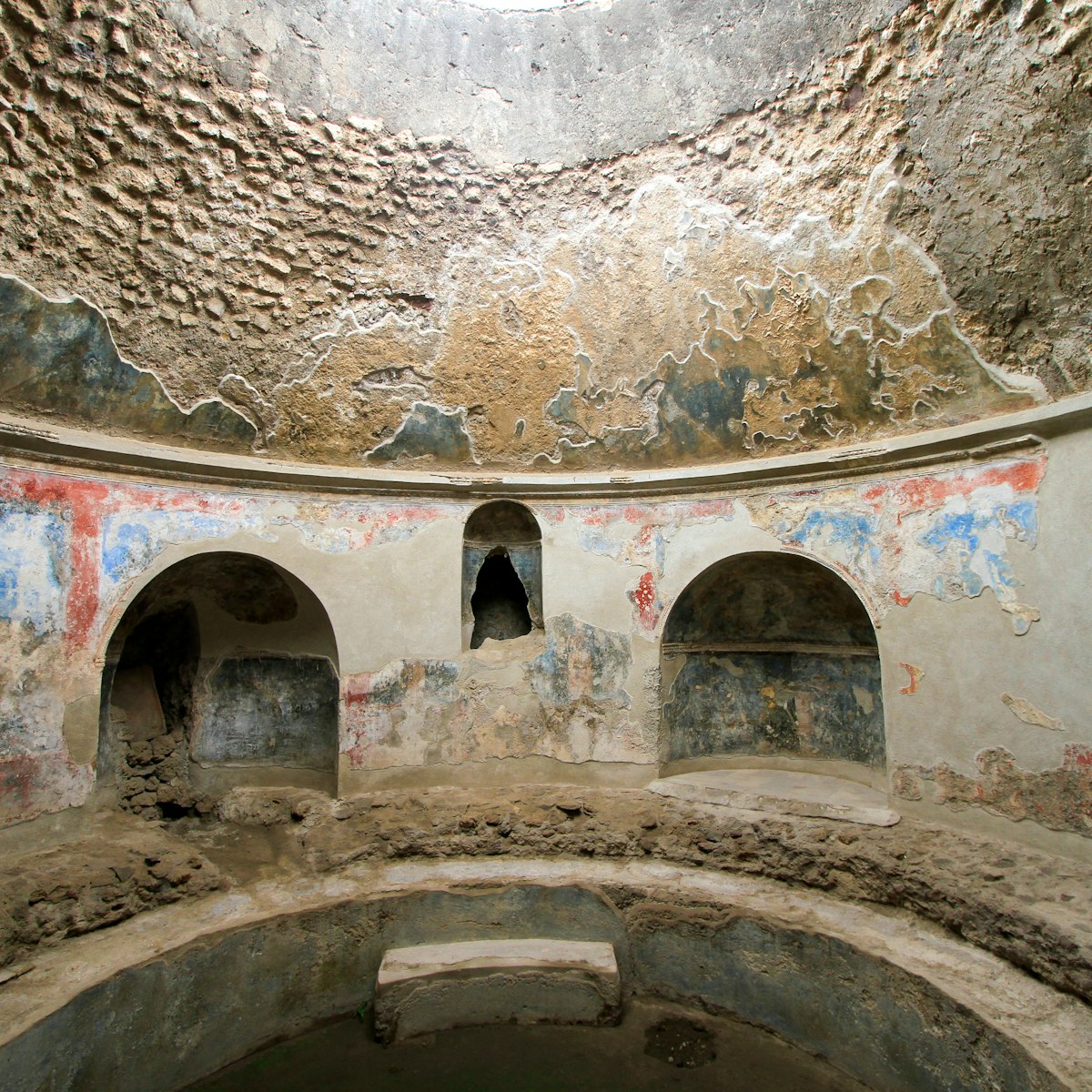
Pompeii
The ghostly ruins of ancient Pompeii (Pompei in Italian) make for one of the world's most engrossing archaeological experiences. Much of the site's value…

Pompeii
The ghostly ruins of ancient Pompeii (Pompei in Italian) make for one of the world's most engrossing archaeological experiences. Much of the site's value…

Pompeii
This restored, 90-room villa is one of the most complete structures left standing in Pompeii. The Dionysiac frieze, the most important fresco still on…

Pompeii
Covering an entire insula (city block) and claiming two atria at its front end (humbler homes had one), Pompeii's largest private house is named after the…

Pompeii
The oldest and most important of Pompeii's religious buildings, the Tempio di Apollo largely dates from the 2nd century BC, including the striking…

Pompeii
At this typical 2nd-century-BC bathing complex, bathers would enter from the vestibule, stop off in the vaulted apodyterium (changing room), and then pass…

Casa della Venere in Conchiglia
Pompeii
Casa della Venere in Conchiglia harbours a lovely peristyle looking onto a small, manicured garden. It's here in the garden that you'll find the large,…

Pompeii
The 1st-century AD Casa del Poeta Tragico features the world's first-known 'beware of the dog' – cave canem – warnings. Visible through a protective glass…

Pompeii
Just outside ancient Pompeii's city walls, this 1st-century-BC bathhouse is famous for several erotic frescoes that scandalised the Vatican when they were…

Pompeii
A huge rectangle flanked by limestone columns, the foro was ancient Pompeii's main piazza, as well as the site of gladiatorial games before the Anfiteatro…

Pompeii
Better preserved than the larger Casa del Fauno, luxurious Casa del Menandro has an outstanding, elegant peristyle (a colonnade-framed courtyard) beyond…

Pompeii
The explicit frescoes at this ancient brothel provided visual 'inspiration' for clients. Once ready, visitors would indulge in one of the five rooms on…

Pompeii
Pompeii's small museum hosts rotating exhibitions showcasing the site's archaeological finds and exploring various aspects of ancient Roman culture. The…

Pompeii
Built in the 2nd-century BC in honour of Jupiter, Juno and Minerva, the Tempio di Giove was a nexus of religious activity. Its surviving elements include…

Pompeii
Gladiatorial battles thrilled up to 20,000 spectators at the grassy anfiteatro. Built in 70 BC, it's the oldest known Roman amphitheatre in existence. In…

Pompeii
Lithe ancients kept fit at the Palestra Grande, an athletics field with an impressive portico dating from the Augustan period. Used both as a training…

Pompeii
The Casa dei Vettii is home to a famous depiction of Priapus with his gigantic phallus balanced on a pair of scales…much to the anxiety of many a male…

Pompeii
The Granai del Foro is now used to store hundreds of amphorae and a number of body casts that were made in the late 19th century by pouring plaster into…

Pompeii
Dating from the 2nd century BC, the macellum was the city's main produce market. Note the 12 bases at the centre of the market, which were once stands for…

Pompeii
The ruin of Pompeii's main entrance is at Porta Marina, the most impressive of the seven gates that punctuated the ancient town walls. A busy passageway…

Pompeii
The 2nd-century-BC Teatro Grande was a huge 5000-seat theatre carved into the lava mass on which Pompeii was originally built. The site hosts the annual…

Pompeii
The Via dell'Abbondanza was one of ancient Pompeii's main streets. The elevated stepping stones allowed people to cross the street without stepping into…

Pompeii
One of Pompeii's ancient city gates, Porta Ercolano was designed with three passageways. While the central one was used for vehicles, the two peripheral…

Pompeii
Behind the Teatro Grande's stage, the porticoed Quadriportico dei Teatri was initially used as a place for the audience to stroll between acts and later…

Pompeii
The basilica was the 2nd-century-BC seat of Pompeii's law courts and exchange. The semicircular apses would later influence the design of early Christian…

Porta Marina Entrance & Ticket Office
Pompeii
One of two main entrances to the ruins of Pompeii, located an 80m walk south of the Pompei Scavi–Villa dei Misteri Circumvesuviana train station.

Pompeii
On the right as you enter the ruin's main entrance is the 1st-century BC Tempio di Venere, formerly one of the town's most opulent temples.

Pompeii
A once-elegant ancient villa attributed to Marcus Arrius Diomedes, whose tomb lies opposite the monumental entrance.




Piazza Anfiteatro Entrance & Ticket Office
Pompeii
One of two main entrances to the ruins of Pompeii.